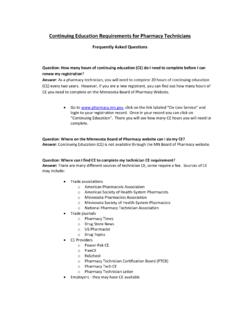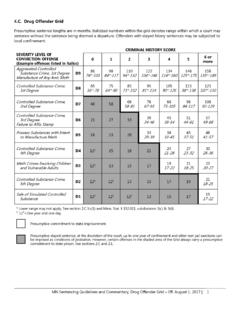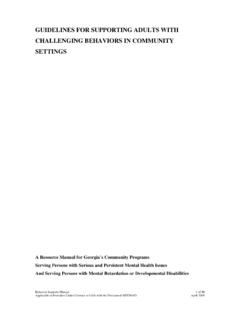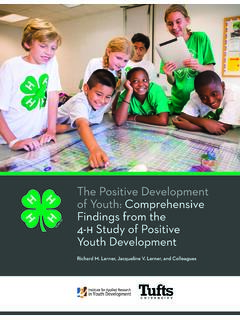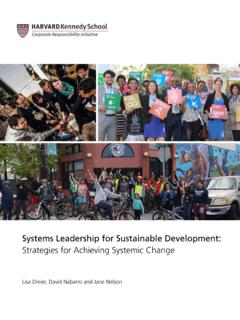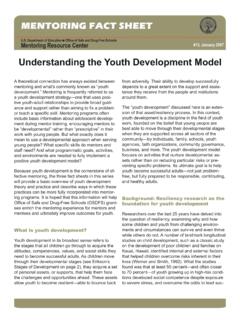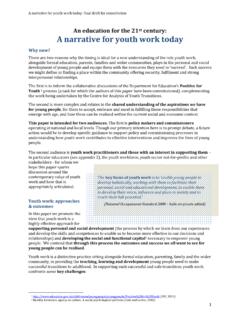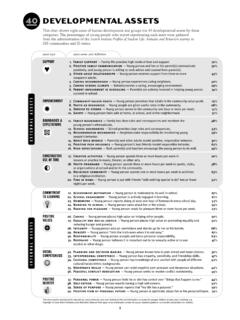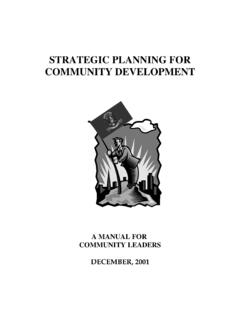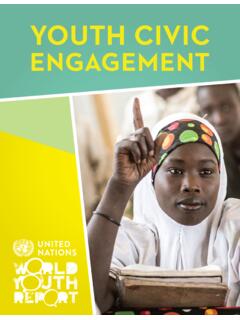Transcription of Youth Development and Youth Leadership in Programs
1 Youth Development and Youth Leadership in Programs What are Youth Development and Youth Leadership & Why are They Important? Research supports the premise that both Youth Development and Youth Leadership Programs positively shape the growth of young people with and without disabilities. Youth Leadership Programs build on solid Youth Development principles, with an emphasis on those Development and program components that support Youth Leadership . Often, and mistakenly, the terms " Youth Development " and " Youth Leadership " are used interchangeably. Youth Development is a process that prepares young people to meet the challenges of adolescence and adulthood through a coordinated, progressive series of activities and experiences that help them to become socially, morally, emotionally, physically, and cognitively competent. Youth Leadership is an important part of the Youth Development process.
2 Youth Leadership is both an internal and an external process leading to (1) the ability to guide or direct others on a course of action, influence their opinion and behavior, and show the way by going in advance; and (2) the ability to analyze one's own strengths and weaknesses, set personal and vocational goals, and have the self-esteem to carry them out. Youth Development experiences are connected to positive outcomes in Youth , including decreases in negative behaviors (such as alcohol and tobacco use and violence) and increases in positive attitudes and behaviors (such This brief describes how administrators and policymakers can use the concepts of Youth Development and Youth Leadership in developing and administering Programs that serve all Youth and activities specifically geared toward Youth with disabilities. The brief is based on a longer paper, Youth Development and Youth Leadership , A Background Paper, published by The National Collaborative on Workforce and Disability for Youth .)
3 The full paper is available online at as motivation, academic performance, self-esteem, problem-solving, positive health decisions, and interpersonal skills). Participation in Leadership Development experiences is linked to increased self-efficacy and the Development of skills relevant to success in adulthood and the workplace such as decision-making and working well with others. Building self-advocacy and self-determination skills, an important aspect of Leadership Development for Youth with disabilities, correlates with making a successful transition to adulthood. Youth Development in Workforce Development The Youth provisions of the Workforce Investment Act (WIA) of 1998 fused Youth Development principles with traditional workforce Development . WIA, the cornerstone of the publicly funded workforce Development system, provides workforce investment services and activities through local One-Stop Career Centers and Youth -serving Programs .
4 The presence of Youth Development principles in WIA reflected the growing consensus that the most effective Youth initiatives are the ones that focus on a wide range of developmental needs. One of the 10 program elements required under WIA is Leadership Development . Research shows that effective Youth initiatives give young people opportunities for new roles and responsibilities in the program and the community. Because Leadership Development and Youth Development are needed by all Youth , and because they have such a prominent role in WIA, NCWD/ Youth identified essential areas of Development and program components for Youth Leadership and Youth Development Programs . The Five Areas of Development Some common competencies and desirable outcomes emerge from a review of Youth Development and Youth Leadership research. The competencies and outcomes are best articulated in a framework created by the Forum for Youth Investment that organizes the range of Youth Development outcomes into five developmental areas: working, learning, thriving, connecting, and leading.
5 Youth Development Programs strive to Youth Development AND Youth Leadership IN Programs provide supports, services, and opportunities that help Youth , including Youth with disabilities, achieve positive outcomes in all five of these areas. While Youth Leadership Programs also help Youth achieve positive outcomes in all five areas, they place more emphasis on developing competencies in the areas of leading and connecting. Using the Forum for Youth Investment's framework, NCWD/ Youth has outlined intended outcomes and examples of program activities for each of the five areas. Working refers to the Development of positive attitudes, skills, and behaviors around occupational and career direction. Positive outcomes that fall under this area include demonstrated work-readiness skills and involvement in meaningful work that offers advancement, satisfaction, and self-sufficiency.
6 Activities such as career interest assessments and summer internships help Youth achieve these outcomes. Learning refers to the Development of positive basic and applied academic attitudes, skills, and behaviors. Beneficial outcomes that fall under this area include rational problem solving and critical thinking. Activities such as group problem-solving games and contextualized learning using academic skills to complete a project help Youth achieve these outcomes. Thriving refers to the Development of attitudes, skills, and behaviors that are demonstrated by maintaining optimal physical and emotional well-being. Beneficial outcomes that fall under this area include knowledge and practice of good nutrition and hygiene and the capacity to identify risky conditions. Activities such as workshops on nutrition and hygiene and role-playing adverse situations help Youth achieve these outcomes.
7 Connecting refers to the Development of positive social behaviors, skills, and attitudes. Positive outcomes that fall under this area include quality relationships, the ability to build trust, and effective communication. Activities such as adult mentoring, positive peer interactions, and team-building exercises help Youth achieve these outcomes. Leading refers to the Development of positive skills, attitudes, and behaviors around civic involvement and personal goal-setting. Beneficial outcomes that fall under this area include a sense of responsibility to oneself and others and the ability to articulate one's personal values. Activities such as the opportunity to take a Leadership role and participation in community service projects help Youth achieve these outcomes. The chart "Five Areas of Development with Related Outcomes and Activities" provides intended outcomes and suggested activities for each of the five areas of Development .
8 The chart includes Youth Leadership program-specific outcomes and activities for the "connecting" and "leading" areas. Organizational and Program Components Youth Development and Youth Leadership Programs for all Youth , including those with disabilities, consist of the same basic components necessary to build on each Youth 's capabilities and strengths and address a full range of developmental needs. Youth Leadership Programs place an additional emphasis on certain components central to Leadership Development . The key components of Youth Development and Youth Leadership Programs can be divided into organizational components practices and characteristics of the organization as a whole that are necessary for effective Youth Programs and programmatic components the practices and characteristics of a specific program that make it effective for young people. In addition, there are some components that comprise a disability focus that Programs should include in order to meet the needs of Youth with disabilities.
9 Organizational Components Both Youth Development and Youth Leadership Programs need to be supported by an organization that has all of the following characteristics: clear goals related to the Development of young people; Youth Development -friendly staff; connections to the community; and Youth involvement. Youth Leadership Programs must emphasize the importance of involving Youth in every facet of the organization, including serving on the Board of Directors, strategic planning, and other administrative decision-making processes. Programmatic Components Youth Development and Youth Leadership Programs should do all of the following: provide varied hands-on and experiential activities; provide opportunities for Youth to succeed and to take on various roles in the program; encourage Youth involvement in developing and implementing program activities; establish high expectations for Youth , and allow them to experience the consequences of their - Development AND Youth Leadership IN Programs CHART.
10 Organization and Program Components Components of Youth Development Programs Clear mission and goals Staff are trained, professional, support-ive, committed, and Youth -friendly Safe and structured environment Connections to community and other Youth -serving organizations Components of Youth Development Programs Focus on each young person's individ-ual needs, assets, and interests Hands-on experiential and varied activities Youth involvement in developing and implementing activities Opportunities for success Opportunities to try new roles Youth Leadership * Mentoring and role models Personal responsibility Family involvement and support * Opportunities for Youth to develop self-awareness, identity, and values ORGANIZATIONAL LEVEL Additional Components of Youth Leadership Programs Youth involvement at all levels, includ-ing administration and the Board of Directors PROGRAMMATIC LEVEL Additional Components of Youth Leadership Programs Hands-on involvement at all program-matic levels such as planning, budget-ing, implementing, and evaluating pro-grams Multiple opportunities to develop and practice Leadership skills Varied, progressive Leadership roles for Youth .






